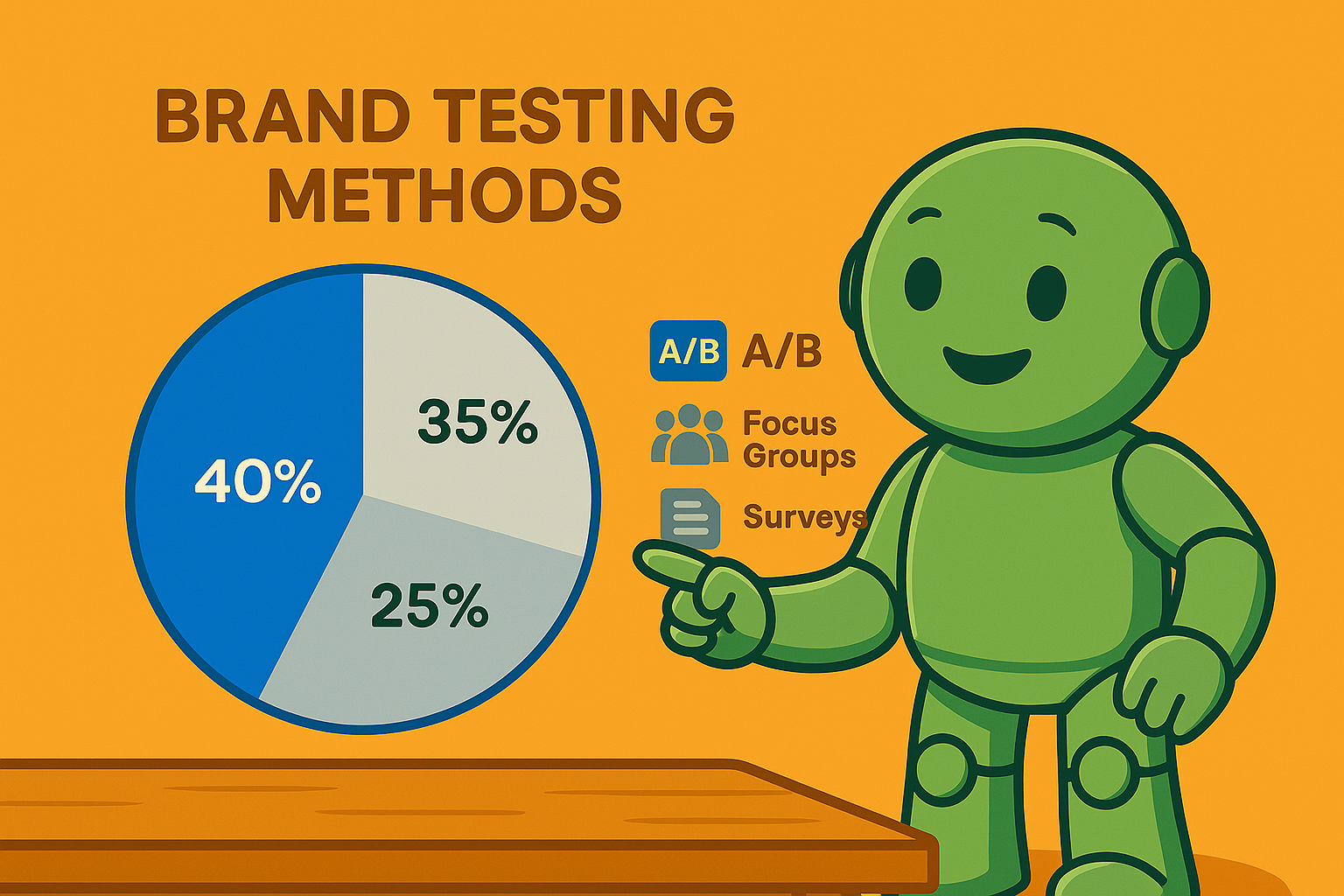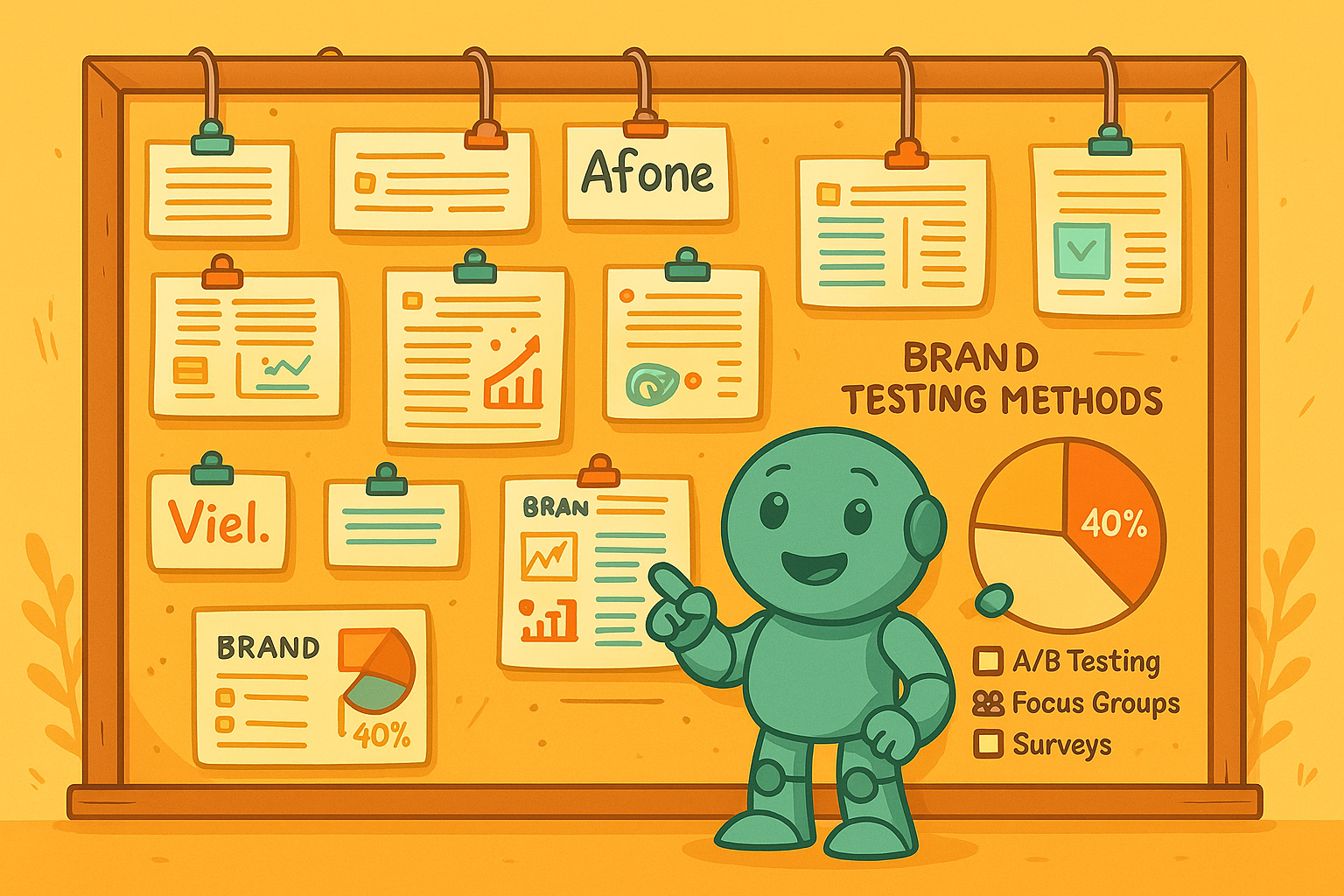Brand Name Testing: Your Complete Strategy Guide
Why Brand Name Testing Changes Everything

In today's competitive business landscape, a brand's name is often the first impression a potential customer has. It forms the foundation for brand recognition, reputation building, and ultimately, customer loyalty. A poorly chosen name, however, can significantly hinder a company's growth and potentially contribute to its decline. This is why brand name testing is essential for businesses focused on success.
The Hidden Costs of Skipping Name Testing
Imagine years of work and substantial investment in a groundbreaking product, only for it to underperform due to a confusing or off-putting name. Or picture the financial implications of a costly rebranding campaign required by a name that failed to resonate or, even worse, generated negative publicity. These are the tangible risks businesses face when they neglect brand name testing.
Even a seemingly minor name change can provoke strong reactions from loyal customers, potentially damaging brand trust. The infamous "New Coke" incident exemplifies this, demonstrating how even a temporary name change can lead to substantial financial loss and harm a company's reputation. A name that doesn't translate well across different languages or cultures can also restrict a company's global expansion and market penetration. These are risks that thorough brand name testing can help mitigate.
The Power of Data-Driven Decisions
Effective brand name testing offers valuable insights into audience perception of a potential name. It helps identify names that are memorable, easy to pronounce, and consistent with the brand's values and personality. Testing can also reveal potentially negative connotations or cultural misunderstandings before they become significant problems.
For instance, research indicates that over 68% of Fortune 500 companies now utilize name testing prior to new product launches or rebranding efforts. Learn more about name testing at Smashbrand. These tests can reduce the risk of adverse market reactions by up to 42% compared to companies that skip this crucial step. This data underscores the increasing importance of data-driven decisions in brand naming.
Adapting to the Digital Age
The digital age has made brand name testing even more critical. In the crowded digital landscape, a memorable and easily searchable name is essential for online visibility and discoverability. The rapid spread of information online means any negative response to a brand name can escalate into a crisis quickly. This reinforces the need for comprehensive testing to proactively identify and address potential issues before they impact a brand's online presence. A strong brand name can significantly differentiate a company in a competitive market and establish a unique online identity.
Choosing The Right Brand Name Testing Methods
A strong brand name is crucial for any business. Choosing the right one, however, requires careful planning and thorough testing. Selecting the wrong testing method can lead to wasted resources and inaccurate results. This exploration delves into the most effective brand name testing methods, ranging from traditional focus groups to modern AI-driven sentiment analysis.
Quantitative vs. Qualitative Testing
Brand name testing methods are broadly categorized as quantitative or qualitative. Quantitative methods focus on gathering numerical data, measuring factors like recall rate and purchase intent. These methods often involve surveys and A/B testing, offering statistically significant insights into audience response. For instance, a purchase intent survey can indicate which name is most likely to drive sales.
Qualitative methods, conversely, explore the emotional and subjective reactions to a brand name. Techniques like focus groups and cultural resonance evaluations investigate the deeper meaning and associations consumers have with a name. This allows brands to understand a name's emotional impact and how well it aligns with their desired brand identity.
Key Brand Name Testing Methods
Several impactful methods provide valuable data for assessing a brand name's potential. Here are some prominent approaches:
- Recall Testing: This quantitative method measures how easily a name is remembered. A high recall rate is essential for brand recognition and a strong brand presence.
- Purchase Intent Studies: These surveys gauge how likely consumers are to buy a product based on its name, directly linking the name to potential revenue.
- Focus Groups: Moderated discussions explore consumer perceptions and emotional reactions, offering rich qualitative data.
- Cultural Resonance Evaluations: This method assesses a name's cultural relevance and appropriateness in different markets, particularly important for global brands.
- Sentiment Analysis: Using AI, this method analyzes online conversations and social media to measure public opinion and sentiment.

The infographic above illustrates the distribution of brand testing methods. A/B testing accounts for 40%, followed by Focus Groups at 35%, and Surveys at 25%. This emphasizes the importance of A/B testing and focus groups. However, a combination of methods often provides the most comprehensive understanding.
Combining Methods for Maximum Impact
While each method has its strengths, combining quantitative and qualitative approaches yields the most actionable results. A/B testing can narrow down a long list of names, while focus groups offer deeper insights into the emotional impact of the finalists. This blended approach ensures the chosen name is both data-driven and emotionally resonant. This empowers brands to make informed decisions based on statistical evidence and consumer sentiment.
To help illustrate the different methods, let's look at a comparison table:
To help you understand these methods in more detail, we’ve provided a comparison table. This table outlines the key features of each testing method, allowing for quick assessment of their benefits and limitations.
Brand Name Testing Methods Comparison
| Testing Method | Timeline | Cost Range | Sample Size | Best For | Key Benefits |
|---|---|---|---|---|---|
| A/B Testing | 1-2 weeks | Low - Moderate | Large | Evaluating different name variations | Statistically significant results, identifies top performers |
| Focus Groups | 2-4 weeks | Moderate - High | Small - Medium | Understanding emotional responses | In-depth qualitative data, explores consumer perceptions |
| Surveys (Purchase Intent) | 1-2 weeks | Low - Moderate | Large | Measuring purchase likelihood | Quantifies consumer interest, links name to potential revenue |
| Cultural Resonance Evaluations | 4-8 weeks | Moderate - High | Varies depending on markets | Assessing cultural appropriateness | Ensures global suitability, avoids cultural missteps |
| Sentiment Analysis | Ongoing | Low - Moderate | Very Large | Monitoring public opinion | Tracks real-time sentiment, identifies potential issues early |
This table summarizes key differences between various brand name testing methods, providing a clear overview of their applications and advantages. Understanding these distinctions is vital for selecting the right approach based on your specific needs and resources.
Cost and Time Considerations
Different testing methods require varying investments of time and budget. Surveys and A/B testing are typically faster and more cost-effective than focus groups or extensive cultural resonance evaluations. The best choice depends on available resources, the complexity of the naming challenge, and the specific insights required.
For additional tools and resources to help you in your naming process, check out our guide on business name generators. Carefully considering these factors is essential for developing a brand name testing strategy that maximizes ROI and helps choose a name that resonates with your target audience, setting your brand up for long-term success.
Building Your Brand Name Testing Process From Scratch

Ready to evaluate potential brand names? A robust testing process is essential for gathering accurate data and making informed decisions. This section offers a practical, step-by-step guide to creating a testing campaign that provides reliable insights.
Defining Your Testing Objectives
First, clarify your goals. What do you want to achieve through brand name testing? Are you measuring memorability, assessing cultural appropriateness, or gauging purchase intent? Well-defined objectives will guide your process and ensure you collect the right data.
For instance, if memorability is your primary goal, you might prioritize recall testing. However, if understanding cultural nuances is key, then evaluations of cultural resonance become essential.
Identifying Your Target Audience
Next, define your ideal customer. Who are you trying to reach? Their demographics, psychographics, and cultural background significantly influence their brand name perception. Testing with a representative sample of your target audience is critical for gathering relevant feedback.
This means if you target millennials, your testing pool should primarily consist of individuals within that demographic. Accurate representation ensures your data reflects the opinions of your intended market.
Creating Effective Testing Materials
Developing unbiased and effective testing materials is paramount. Avoid leading questions that might skew responses. For example, instead of asking, "Do you like this name?", consider, "What are your initial impressions of this name?".
Ensure your questions are clear, concise, and easy to understand. Offer a variety of response options to capture the full spectrum of participant feedback. This allows for more nuanced insights and a richer understanding of audience sentiment.
Choosing the Right Testing Method
Selecting the appropriate testing method is crucial. Will you use online surveys, focus groups, or A/B testing? Each method has strengths and weaknesses. Consider your budget, timeline, and the data you need.
If resources are limited, online surveys might be more feasible than in-person focus groups. However, focus groups provide richer qualitative data. Carefully consider which method aligns best with your specific needs and resources.
In-House vs. Outsourced Testing
Decide whether to conduct testing internally or outsource to a specialized agency. In-house testing offers greater control, while outsourcing provides expertise and often specialized tools. Weigh the pros and cons based on your internal capabilities and budget.
Building stakeholder buy-in is crucial regardless of your chosen approach. This involves communicating the importance of brand name testing and demonstrating its potential ROI. Clearly presenting the value proposition of testing helps secure necessary resources and support.
Navigating Global Brand Name Testing Challenges
A brand name can make or break a product's success, especially in the global marketplace. A name that resonates strongly in one country might be meaningless, or even offensive, in another. That's why international brand name testing is a critical component of any global expansion strategy. Successfully launching a brand across borders requires a deep understanding of linguistic and cultural nuances. This can mean the difference between a successful product launch and a PR disaster.
Understanding Cultural Context in Naming
Effective brand name testing in international markets requires more than simple translation. It demands a thorough understanding of the target culture's values, beliefs, and sensitivities. A seemingly harmless name in English might carry unintended negative connotations in another language. The classic example is Chevy's attempt to introduce the Nova to Spanish-speaking markets. "No va" in Spanish means "no go," which understandably hindered sales. This highlights the crucial role of localized brand name testing in achieving global success.
Strategies for Multi-Market Testing
Testing a brand name across multiple markets simultaneously presents logistical challenges. Coordinating research, managing diverse respondent groups, and interpreting multilingual data require careful planning and execution. However, this approach enables brands to identify potential naming conflicts early on and develop a global naming strategy that balances consistency with cultural relevance.
- Leverage Technology: Online platforms like SurveyMonkey and translation services such as Google Translate are essential for efficiently gathering feedback from diverse populations. These tools streamline the process and ensure accurate data collection across multiple languages.
- Local Expertise: Partnering with local market research firms offers invaluable insights into cultural nuances and ensures testing materials are appropriate for each target market. This collaboration strengthens the effectiveness and cultural sensitivity of your brand name testing methods.
- Clear Objectives: Defining specific goals for each market before testing is essential. This maintains focus and allows for easier comparison of results across different regions.
Balancing Global Consistency and Local Relevance
Maintaining a consistent brand identity across all markets is often a key objective. However, adapting the name to specific cultural contexts is sometimes necessary. This requires balancing global brand recognition with local market acceptance.
Coca-Cola, for example, maintains a consistent name globally while tailoring its marketing campaigns to resonate with local cultures. This approach builds global brand recognition while acknowledging cultural differences, ensuring both global brand building and local market penetration. Finding this balance is crucial for sustained global success.
Adapting vs. Universal Consistency
Deciding when to adapt a brand name versus maintaining universal consistency is a strategic choice. Factors such as the brand's industry, target audience, and marketing message must be considered. A completely different name might be the best approach for one market, while minor adjustments may suffice for another. Careful consideration of these factors is paramount to building a globally successful brand. Through diligent research and planning, you can navigate these complex challenges and create a brand name that resonates across borders.
Proving The ROI Of Brand Name Testing Investments

Securing budget for brand name testing can be a challenge, especially when resources are limited. Demonstrating a clear return on investment (ROI), however, is essential for gaining stakeholder support. This section explores the tangible advantages of brand name testing and its correlation with strong market performance. This data-driven approach moves beyond gut feelings and provides concrete evidence of the value of testing.
Measuring The Impact Of Brand Name Testing
Effective brand name testing is a strategic investment, not just a cost. Studies reveal a direct link between comprehensive testing and improved key performance indicators (KPIs). Consider metrics like increased revenue growth, greater market share, and enhanced brand valuation. These are quantifiable results directly attributable to a strategically chosen brand name.
The long-term implications of brand name testing are also significant. A powerful brand name cultivates customer loyalty and builds stronger brand equity over time. A memorable and resonant name fosters positive brand associations, improving customer retention and strengthening market presence. This establishes a foundation for sustained growth.
Furthermore, thorough brand name testing helps mitigate the risk of costly rebrands later. Addressing potential naming conflicts early prevents expensive and disruptive rebranding campaigns down the line. This proactive approach saves valuable resources and protects brand reputation, ensuring a consistent brand identity from the start.
Research from leading consulting firms indicates that brands investing in pre-launch name testing have a 50% greater likelihood of achieving above-average market share in their first year. A study of European and North American brands revealed that companies conducting name tests with at least 1,000 respondents per market experienced a 23% higher revenue growth rate compared to those that didn't. More statistics on brand value can be found here. These findings underscore the considerable influence of brand name testing on market success.
Calculating Potential ROI
Calculating potential ROI for brand name testing involves evaluating both the costs and potential returns. Costs encompass expenses related to conducting the testing process itself, such as survey fees, focus groups, and consultant fees. However, the potential benefits often significantly outweigh these initial costs.
When evaluating potential returns, consider factors like increased brand awareness, improved conversion rates, and reduced marketing spend. A name that resonates deeply with the target audience can enhance brand recall and customer engagement, translating to increased sales and revenue.
For more insights into the naming process, explore this resource: How to come up with a business name.
Building A Compelling Business Case
To build a compelling business case for brand name testing, clearly articulate the potential benefits. Present data-driven insights that demonstrate how testing mitigates risk and maximizes return. Real-world examples of brands that have successfully leveraged name testing add further credibility to your argument.
Highlighting the potential negative consequences of forgoing testing is equally important. Brand confusion, negative publicity, and diminished market share are potential pitfalls that underscore the importance of investing in comprehensive brand name testing. By effectively showcasing the value of this investment, you can secure the necessary resources to ensure long-term brand success.
To illustrate the potential ROI of brand name testing, consider the following table:
Brand Name Testing ROI Metrics
Key performance indicators and financial metrics that demonstrate the value of brand name testing investments
| Metric | With Testing | Without Testing | Improvement | Time Frame |
|---|---|---|---|---|
| Market Share | 18% | 10% | 8% | Year 1 |
| Revenue Growth | 23% | 10% | 13% | Year 1 |
| Brand Awareness | 65% | 40% | 25% | Year 1 |
| Customer Loyalty (Retention Rate) | 80% | 65% | 15% | Year 2 |
| Cost Avoidance (Rebranding) | $0 | $50,000 | $50,000 | Year 3 |
This table provides a snapshot of the potential positive impact of brand name testing across various crucial metrics. While these are illustrative figures, they represent the kinds of improvements that can be achieved through strategic investment in brand name testing. By demonstrating these potential returns, organizations can justify the allocation of resources to this crucial branding activity.
Avoiding Costly Brand Name Testing Mistakes
Even the most meticulously planned brand name testing can fall short, leading to confusing results and ultimately, poor naming choices. This section examines common – and costly – errors companies make, offering practical strategies to avoid these pitfalls. We'll analyze examples of testing gone wrong, highlighting issues like survey bias and insufficient sample sizes that can invalidate research. These mistakes can lead to significant financial losses and damage a brand's reputation.
Recognizing Red Flags in Your Research
One frequent mistake is survey bias, where questions subtly influence responses. For example, asking "Do you find this name appealing?" encourages positive answers compared to a more neutral phrasing like, "What words come to mind when you hear this name?" This seemingly small difference can dramatically skew results.
Another critical error is using an inadequate sample size. A small sample may not accurately represent your target audience, leading to misleading insights. Imagine testing a name only with a small group of friends and family—their feedback might not reflect the broader market. Testing with a sufficiently large and diverse group is crucial.
Timing mistakes also significantly impact results. Testing a name too early, before the brand identity is fully defined, can lead to irrelevant feedback. Conversely, testing too late, after investing heavily in branding materials, limits your ability to implement changes.
Quality Control and Validation Techniques
Implementing quality control measures throughout the testing process is crucial. This includes:
- Carefully reviewing survey questions for bias
- Ensuring diverse representation in your sample group
- Establishing clear criteria for evaluating results
Think of this as a checklist for your testing process, ensuring everything is in order.
Validating your findings through multiple testing methods is another best practice. If both your survey and focus group point to the same preferred name, you can have greater confidence. This cross-validation strengthens reliability and minimizes risk. Learn more in our article about How to Decide on a Name.
Interpreting Conflicting Results
Sometimes, test results might conflict. For instance, quantitative data might favor one name while qualitative feedback favors another. This necessitates careful analysis and interpretation. Consider the weight of each data point and its relevance to your brand strategy. You might also be interested in: How to Master...
One approach is exploring the why behind preferences within qualitative data. Understanding the reasoning can provide deeper insight than numerical data alone, helping you reconcile discrepancies and make informed decisions.
Maintaining Objectivity
Maintaining objectivity throughout the brand name testing process is crucial. Avoid becoming overly attached to a particular name. Be open to unexpected results and willing to adapt. Remember, the goal is to find the best name for your brand, even if it differs from your initial preference.
By following these best practices, you can avoid costly mistakes and ensure your brand name testing provides valuable insights. This will help you choose a name that resonates with your target audience, supports your brand strategy, and sets your business up for success.
Key Takeaways
Your brand name testing journey doesn't have to be a gamble. By understanding core principles and implementing the right strategies, you can transform this critical process into a powerful engine for brand growth. This section distills essential takeaways from industry best practices and real-world experiences to provide a practical roadmap for success.
Essential Strategies for Brand Name Testing
-
Define Crystal-Clear Objectives: What are your goals? Are you aiming for memorability, cultural relevance, or strong purchase intent? Clearly defined objectives will guide your choice of testing methods and the metrics you use to measure success.
-
Identify Your True Target Audience: Testing with a representative sample of your ideal customer is paramount. Their perceptions and associations are vital for accurate insights. Understanding their needs and preferences will help you choose a name that resonates with them.
-
Create Unbiased Testing Materials: Use neutral language in surveys and focus groups to avoid leading questions that could skew responses. For example, instead of asking "Do you like this name?", ask "What words come to mind when you hear this name?". This approach encourages more authentic feedback.
-
Combine Quantitative and Qualitative Methods: Leverage both quantitative methods like surveys and A/B testing for statistical significance, and qualitative methods like focus groups for deeper emotional insights. This combination provides a well-rounded understanding of how your target audience perceives your brand name.
Warning Signs: Mistakes to Avoid
-
Survey Bias: Carefully review your survey questions to ensure neutral phrasing and avoid leading respondents towards specific answers. Biased questions can invalidate your results.
-
Inadequate Sample Size: A small or unrepresentative sample can lead to inaccurate and misleading results. Aim for a large and diverse group that accurately reflects your target market.
-
Timing Mistakes: Testing too early or too late in the branding process can limit the usefulness of your findings. Conduct testing when you can still implement meaningful changes based on the feedback received.
-
Ignoring Cultural Nuances: For global brands, cultural resonance evaluations are critical. Overlooking this aspect can lead to unintended negative connotations or meanings in different markets.
Measuring Success: Metrics That Matter
-
Recall Rate: How easily is the name remembered? This reflects the brand's potential for recognition and recall.
-
Purchase Intent: How likely are consumers to buy a product with this name? This metric directly links the name to potential sales and provides valuable insight into its market viability.
-
Emotional Response: What feelings and associations does the name evoke? Qualitative data reveals the emotional impact of the name and helps you understand how it resonates with your target audience.
-
Cultural Appropriateness: Does the name translate well and resonate positively in all target markets? This is essential for global brands to avoid misinterpretations and ensure a consistent brand image.
Actionable Checklists and Timelines
For practical implementation, consider the following:
Checklist for A/B Testing:
- Define clear variations of the name to test.
- Establish a representative sample group.
- Set a specific timeframe for testing.
- Analyze results based on pre-defined metrics.
Timeline for Focus Groups:
- Recruit participants (2-4 weeks).
- Develop discussion guide (1-2 weeks).
- Conduct focus groups (1-2 weeks).
- Analyze and interpret findings (1-2 weeks).
Benchmarks for Business Sizes
-
Small Businesses: Often benefit from cost-effective online surveys and smaller focus groups.
-
Medium-Sized Businesses: Can invest in larger-scale surveys and more extensive focus group research.
-
Large Enterprises: Should consider comprehensive testing strategies encompassing both domestic and international markets, potentially utilizing specialized agencies.
Each takeaway offers clear steps and measurable criteria to ensure your brand name testing process is not only effective but also delivers tangible results that contribute to your brand’s long-term success.
Ready to transform your brand naming process? NameRobot offers a suite of powerful tools and resources, from AI-powered name generators to trademark checking and usability analysis. Visit NameRobot today and discover how we can help you find the perfect name for your brand.















